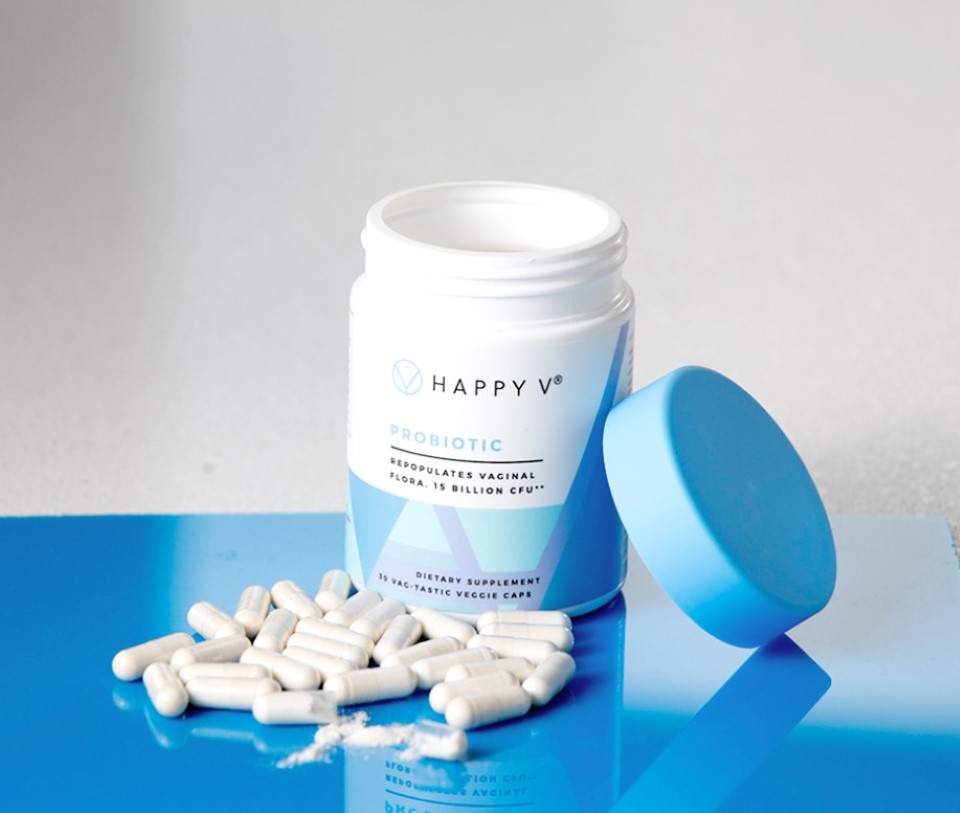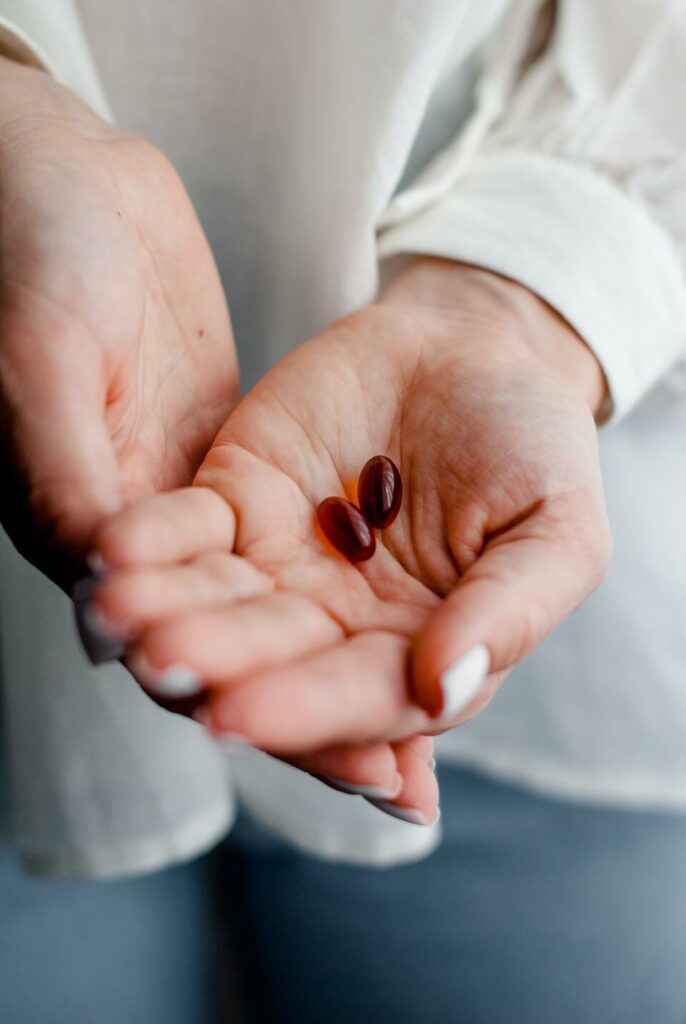- Purchasing a probiotic can seem intimidating at first, but by understanding the terminology associated with probiotic supplements, finding the right one will be easy.
- A probiotic’s name is defined by its genus, species, and strain. The strain is arguably the most important.
- Colony forming units are the proper way in which a probiotic should be measured on the back of a supplement label.
- Just because a supplement has many strains and a high CFU count, doesn’t mean that it is effective for both balancing vaginal pH and promoting digestive health.
- The best species of Lactobacillus for vaginal health include acidophilus, rhamnosus, and reuteri.
If you’ve ever heard of probiotics before, you may know they’re praised for their ability to regulate your gut health by promoting the natural growth of healthy bacteria. But did you know that probiotics can actually work that same magic in your vagina? That’s right—probiotic supplements have many health benefits, including maintaining a natural balance of healthy bacteria in your vaginal tract.
Unfortunately, many businesses and advertisers selling subpar products have caught wind of the important role of probiotics in our everyday health and have flooded the market with inefficient products with unsubstantiated, or unproven, benefits. So if you want to add a probiotic supplement to your diet to promote a healthy balance of bacteria in your gut and vagina, how do you know which probiotic formulation will work best for you?
OB/GYN Dr. Peskin has personally experienced the challenge of recommending specific probiotics to patients. According to Dr. Peskin, he’s seen a significant increase in demand for probiotics from his patients, who come to him asking which products they should take.
The problem is when my patients ask whether or not a product is good; it’s difficult to say yes or no because the evidence for a specific strain may not be there.
To help you choose the right probiotic supplement—whether it’s Happy V’s® or another brand’s probiotics—we’re breaking down everything you need to know to choose the best vaginal probiotic for you. We’ll go over everything from terminology to beneficial strains of probiotics and the clinical efficacy of different types of bacteria, so you can find a probiotic that gives you a happy v.
What Is a Probiotic?
Probiotics are beneficial bacteria that support gastrointestinal health, the health of the vaginal tract, and your body’s overall functioning. There are literally trillions of good bacteria that help keep your immune system in check, maintain acidic pH levels in the vagina, and aid with digestion. Probiotic bacteria are good bacteria responsible for accomplishing all these benefits.
Bacteria are single-celled microscopic organisms that survive in all environments, including in every organ of the human body. From your digestive tract to your vaginal environment to your bowels (and just about everywhere in between!), there are trillions of both good and bad bacteria living in harmony and competing for nutrients that will determine your health.
The important thing to understand when it comes to your body’s health is that your body naturally contains some potentially harmful bacteria. For instance, urinary tract infections are typically caused by e.Coli bacteria naturally occurring in your body. The goal of taking probiotics is not to eliminate all bad bacteria but to promote bacterial balance so the body stays healthy.
How To Choose the Best Probiotic Supplement for You
When you purchase food products or proteins, understanding the nutritional panel is pretty straightforward. A probiotic supplement is vastly different. Unlike a traditional supplement or food product, probiotics contain no calories and or nutrients, in most cases. Instead, they contain scientific-sounding ingredients such as lactobacillus, and instead of using grams, ounces or milligrams for the quantity, it uses an unfamiliar measurement standard called colony-forming units, or CFUs.
Understanding the jargon that you may find on the label of a probiotic capsule can help you choose the best product for the particular health benefit you are seeking.
Understanding a Probiotic Culture’s Name
When you look at a probiotic supplement label, you’ll often notice multiple lactobacillus species in the same formula. Before you get overwhelmed, here’s all you need to know:
Every probiotic culture can be broken down into three elements: the genus, species, and strain. For instance, Happy V® probiotics for women contain the probiotic Lactobacillus Acidophilus LA-14®.
Lactobacillus is the genus, acidophilus is the species, and LA-14® is the strain.
What Is a Probiotic Genus?
All living organisms are broken down into a species and genus. For example, you may know the latin name for humans is “Homo sapien.” In this example, “Homo” is the genus, and “sapien” is the species. Most probiotics on the market consist of the two main genera which have been heavily studied: Bifidobacterium and Lactobacillus.
Bifidobacteria is a gram-positive, nonmotile, often branched anaerobic bacteria. This bacteria is one of the major bacteria that inhabit the gastrointestinal tract, vagina, and mouth of mammals. Clinical studies show this species of bacteria supports the immune system, limits the growth of bad bacteria, and helps break down lactose. (1)
The Lactobacillus genus of bacteria produces lactase and lactic acid. Lactic acid helps inhibit the growth of bad bacteria, which are sometimes called pathogens. The Lactobacillus probiotic genus is especially important for any health concerns related to the vagina, as the vaginal flora is made up predominantly of lactobacillus probiotic species.
However, simply purchasing a probiotic labeled as a Lactobacillus probiotic isn’t enough to ensure it will be beneficial for your vaginal health. In order to determine whether you’ll reap all the benefits of probiotics, you need to know exactly which species of lactobacillus are being included.
What Is a Probiotic Species?
Probiotic species are genetically different subsets of bacteria that still fall under the same genus. As a result, they will have different therapeutic benefits for different parts of the body.
The most common probiotics species you’ll probably come across are L. acidophilus, L. rhamnosus, L. reuteri, L. crispatus, B. breve, and B. coagulans—all of which are found in Happy V ® probiotic for vaginal health. Note that some of these species are Lactobacillus bacteria, and others are Bifidobacteria bacteria.
The most important species when it comes to vaginal wellness will be Lactobacillus acidophilus, as this species makes up 95% of the vaginal flora.
Now that you know how to identify probiotics components, you will be able to look for the right species for your health. But there’s still one thing you need to understand before choosing the best probiotic for you: the probiotic strain.
What Is a Probiotic Strain?
To get the most effective dietary supplement, you must thoughtfully choose the right probiotic strain. On a probiotic label, the strain is indicated by the random letters and numbers after the species name.
To illustrate the point, let’s use an example. Consider two types of dogs, the American labrador and the English labrador. Both are dogs, so they share the same genus. Both are labradors, so they share the same species. But they’re not the exact same type of dog! English labradors are usually heavier with a thicker coat, whereas American labradors typically have a more narrow head and a longer snout. You could say these dogs are different labrador strains.
To bring it back to the point at hand, Happy V® probiotics for vaginal health contain Lactobacillus (genus) acidophilus (species) LA-14® (strain).
LA-14® is a clinically proven L. acidophilus strain that was shown to colonize the vagina in 40 women in a double-blind placebo-controlled clinical study at a dosage of 8 billion CFU per day. (2)
What you need to understand is that the Lactobacillus acidophilus species was not proven to do this, only the lactobacillus strain LA-14 ® was shown to have this effect. Some advertisers will “borrow” clinical research and market it for their probiotic, even when the research doesn’t pertain to the strain in their product. That’s why it’s important to do research on probiotic strains before purchasing a probiotic supplement.

Beneficial Probiotic Strains for Women’s Health
Some probiotic strains have been specifically shown to provide benefits to women. The best probiotic for women include:
- Lactobacillus acidophilus, which helps maintain an acidic environment in the vagina
- Lactobacillus rhamnosus, which supports digestive and immune health and assists with healthy weight management
- Lactobacillus reuteri, which supports women’s’ digestive systems
Choosing a Probiotic Dosage
The last thing to consider when choosing a vaginal probiotic is the dosage. Let’s use some of the strains in the Happy V® probiotic to better understand dosing.
The required dosing ranges from .5 billion (Lactospore®) to 10 billion (Profem® patented L. rhamnosus and L. acidophilus). It’s important to note that focusing on the total probiotic count listed on a front of a probiotic label may mislead you—the count of certain strains is really what matters.
What Are CFUs, and Do They Matter?
CFUs are the unit measurement that should be used on a supplement label. Do not purchase products that use milligrams instead of CFUs.
While you may think you want the probiotic supplement that has the most overall CFUs, that’s actually not true. The best probiotic contains an adequate volume of CFUs of the probiotic strains clinically proven to support your health goals. Good probiotics should also have the same number of CFUs in each serving.
Some brands profess to contain many different strains of bacteria while promoting their overall CFUs at a low price. However, they don’t put adequate CFUs of beneficial strains into their probiotic capsules. This practice is called probiotic stuffing.
Probiotic stuffing is the practice of including dozens of strains at low dosages in order to “stuff” the label with more probiotic cultures, making the product seem more attractive to the end consumer.
There are many ways that probiotic stuffing can occur:
- Advertisers can include a single or very few great bacterias at the right dosages and then add more ineffective probiotic cultures so they can stuff the supplement facts label.
- Advertisers can use a high number of cheap, ineffective probiotic strains and then lower the dosage on the effective ones to cut costs while still including them on the label.
- Strains can be batched into a proprietary blend, and the exact amount of CFUs per strain may not be shared at all.
I’ve Chosen a Probiotic: Is it Working?
The best way to determine if your probiotic is working is to pay attention to your body. Remember what health benefits you were looking for when you started taking the probiotic. What symptoms were you experiencing, and have they been alleviated through the use of the product? If you find that you are feeling better, then continue your probiotic regimen for the most relief from your health issues.

Should I Take Probiotics Daily?
The short answer is yes, you should be taking some form of probiotics daily. However, if you are consuming probiotic-rich foods like yogurt, kefir, cheese, and kimchi, you may not need to take a probiotic every day. If, on the other hand, your diet limits your probiotic intake, like for individuals who consume a dairy-free diet, then a probiotic supplement is recommended for daily use.
Probiotic Serving Size
The amount of probiotics you should take each day depends on your diet and health issues. When trying to determine the correct serving size of probiotics, always consider the following:
- What benefits are you trying to achieve?
- What are the probiotic genus, species, and strain you are taking?
- Does the strain have clinical studies to back up the potential benefits you seek?
- If so, does the supplement you are purchasing have the same number of colony-forming units (CFUs) to achieve a benefit?
If your answer to all of these questions is yes, then you may take the amount recommended in the directions on the back of the supplement label.
For Clinically Proven Probiotics, Choose Happy V
Happy V® probiotics are packed with six specific strains that introduce good bacteria and optimize the pH level of your vaginal flora. We have specially formulated probiotic capsules for individuals with menopause and those experiencing bacterial vaginosis (BV) as well as everyday probiotics to support your vaginal health. If you want to prevent vaginal infections and promote bacterial balance in your body, try Happy V’s proven probiotic supplements.
- Probiotics—Living bacteria and yeasts that are beneficial for you, especially your digestive system and normal flora in the vagina.
- Lactobacillus—A rod-shaped bacterium that produces lactic acid and hydrogen peroxide from the fermentation of carbohydrates in order to multiply and stave off pathogenic bacteria.
- Genus—A principal taxonomic category that ranks above species and below family.
- Species—A group of living organisms consisting of similar individuals capable of exchanging genes or interbreeding.
- Strain—Genetic subtypes of probiotic species
- Colony-Forming Units (CFU)—A unit of measurement used to estimate the number of viable bacteria or fungal cells in a sample
- https://www.ncbi.nlm.nih.gov/pmc/articles/PMC4908950/
- https://www.ncbi.nlm.nih.gov/pmc/articles/PMC5806794/




